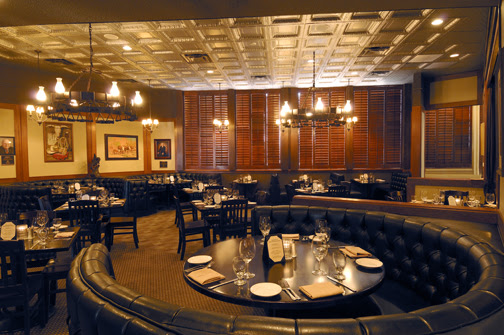The building itself, which sat in the middle of Arizona’s thriving cattle industry could have easily been converted back into cattle pens — or maybe worse, left to rot — but the Tovrea family opted to not only re-build, but expand what was just a sleepy little coffee shop for the cowboys and cowgirls working in the cattle industry to grab a quick meal at into something more substantial.
Something lasting.
The Stockyards, which has always been and potentially always will be located on Washington Street on the south side of the road just a little east of 48th Street, is (and bear with me on this not really too appetizing of an analogy) kind of like a cat. The almost 70-year-old steakhouse seems to have an abundance of lives, and keeps on trucking even in this day and age of the newer, hipper, more functionally elegant food purveyors of Phoenix we’re living in right now. To be honest, there are easier places to get to and more desirable areas of town to spend your hard-earned money, but the Stockyards has that certain something, what the French would call a “je ne sais quoi” you won’t find anywhere else in the world.
To this end, the Stockyards is a bit of an anomaly in the Phoenix food scene. While it has been through several renovations over the years, it is still the same basic place it has been for as long as many Phoenicians care to remember. Longtime fans of the Stockyards are quick to remember certain key features, such as a favorite cut of steak offered or the beautiful bar or the tremendous collection of Western art and cool old photographs adorning the walls, but it is also one of the few Valley constants from multiple eras of Phoenix history. Here is a place that adores the world that birthed it, yet also has to carve out a niche in the rapidly expanding foodie universe that is growing in the mid-to-late teens here in town.
Until relatively recently, I was under the sad idea that the Stockyards had finally gone up to the big cattle ranch in the sky. The restaurant itself does very little in terms of promotion, and with the addition of the light rail running east and west along Washington, it is very easy to avoid the street entirely anymore. It’s not like the building is right there on the street with great visibility as you cruise along Washington, either, in your car at 45 miles per hour or while riding the train. It sits off the beaten path a bit, surrounded by some of the cooler architecture in the area and sort of looking like a forgotten wing of a small-town hospital.
Gary Lasko, managing partner of the Stockyards, which also bills itself as Arizona’s Original Steakhouse, has a true love for his restaurant that is, both at best and worst, infectious, as he tells me about the restaurant’s vaunted history. At 64 and almost five decades into his career in the industry, Lasko is a seasoned vet with experience in a number of fine-dining establishments, but it is clear he is truly at home at the Stockyards.
“Originally, it was just a little café. Really just a coffee shop and a café to feed all of the cowboys that worked in the pens. This (area) was the center of the Arizona cattle industry from 1919 until 1970. That’s when they moved the cattle out. It got kind of political. The prevailing wind blew down towards ASU, so they started complaining,” says Lasko, who, with partners Mike and Gary Smith, have owned the Stockyards for the past 12 years.
Admittedly, I haven’t been in the Stockyards while Lasko has been in charge. My last visit to the restaurant, with relatives for a holiday meal in the early 2000s, was not a fond memory. Service had slumped, the food had gone downhill (and was way chewier than I was hoping for), and even the beautiful bar had seemed a little more ordinary at the time. I remember thinking that the longtime restaurant had probably seen its best days. It seemed a shame because when I think of “old-school” local steakhouses, there are really only two I think of when it comes to Phoenix: the Stockyards and Durant’s.
While the two have had a friendly competition over the years, they are separated enough geographically to not feel like they are stepping on each other’s toes. They also have a completely different feel, as well. I’ll get more into Durant’s, which has that sort of Rat Pack, “I could be in any major city in America” feel, but the Stockyards is all about Arizona and the cattle industry. There is a feeling of local authenticity when you drive into the parking lot that a lot of local restaurants just don’t have anymore. It’s historic Phoenix, and it takes you back a little bit. You can almost close your eyes and smell the cattle again.
As Lasko re-affirmed, the Stockyards is an important part of Arizona history, even a little beyond the restaurant world. There are not many restaurants still around from 1947, and Phoenix is a very different city. Much of what sits east of the Stockyards today did not exist, for example, although you could say the same for much of what is north as well. In the main dining room, there are a number of tables that are dedicated to distinct parts of Arizona’s past, and the individuals who made the history they pay tribute to. How many places can you eat a steak and truly be part of history, as well? For some, this is a special thing but to others, there is the chance it could come off a little hokey and forced. Lasko’s affinity for the restaurant straddles this line elegantly, though, and helps to create a truly genuine atmosphere that any open mind will pick up on during the course of a lunch or dinner.
It is very pleasant to report that not only has the Stockyards survived, but it is thriving. Technically, they don’t serve Rocky Mountain Oysters anymore (now they are called Paloma Ranch Calf Fries and, according to Lasko, “Many people come to the restaurant just to enjoy them”), but it is still welcoming.
“It’s got a lot of stuff to it, components, that newer restaurants don’t have. I like the old-school, American concept. There is so many contemporary American restaurants.”
He pauses. “Look at me, I’m almost 65, I’m an old guy, but I don’t look so old bouncing around in this building. If you stick me one of the newer fast-casual places, I’d stick out like a sore thumb. I kind of look like I fit here.” Lasko’s easygoing demeanor and slightly Midwestern accent give off the immediate impression he would be good to work for.
During the restaurant’s 1954 renovation they added the bar, which for my money is the centerpiece of the restaurant, as it is nothing short of beautiful. The original work, which cost $15,000, would be more like $750,000 to replicate today, according to Lasko, due to the lack of the available resources to replicate the ornate carvings (done by Russ Kapp) in the cherry-stained Honduran mahogany the bar is carved from, plus the time to recreate it.
Menu-wise, if you haven’t visited the Stockyards before or it’s been a long time, it is very traditional steakhouse fare.
Tom Reardon: Phoenix Newtimes

